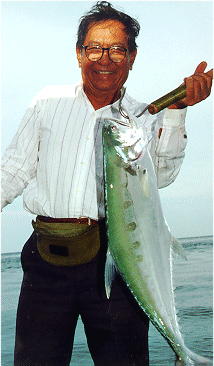



 Queenfish
Queenfish
Scomberoides tol & Scomberoides commersonnianus a.k.a. Talang, Seliap, Tok Pekong Hu, Leatherskin. This shiny chrome coloured pelagic fish is known for its spectacular jumping capers when hooked up. It is popular with light tackle sport fishermen due to its energetic attempts to escape and, of course the entertainment of the aerial display. The queenfish is found all along the coastline, from estuaries, river mouths, kelongs, ship wrecks and rocky outcrops to coral reefs. It often can be caught as large as 7 to 8 kgs, especially in areas of low fishing pressure. However it is normally caught in the region of one to four kilograms around our coastal waters. Surface action Small queenfish can often be found in big schools near the coast, churning the surface. When this happens the water looks like it is boiling, due to the multitude of fish feeding frenziedly just beneath the surface. A good indicator of this occurrence is to keep a look out for a flock of birds gathered over a specific spot. As the birds can be seen from a good distance away, the angler can head to the birds' direction. Within a few hundred yards, the churning of the waters surface will become visible. A sight behold, setting one's heart a pounding with anticipation! This spectacle happens whenever a school of bait fish is herded to the surface by larger predatory fish like queenfish, bonito (tongkol) or even long toms (todak). The predators will circle around and below the school of bait fish, picking off morsels here and there. The birds attracted to the fish near the surface will take advantage of the easy pickings. They can be seen diving down to pick off the small bait fish, while the flock continues to circle the frenzy, awaiting the right opportunity. So keep a look out for these flocks of birds over the sea. They often indicate where fish are feeding near the surface. The fight One often knows when a queenfish has been hooked up when fishing deep: a sudden take and the line starts to whiz off to the side, fast! Most fish would just hit and fight vertically, seeking to head deeper. The queenfish heads off horizontally, constantly changing directions, sometimes heading back straight to the sport fishermen, making the line go slack! Therefore, crank the reel fast to take up the slack, or else the fish might throw the hook! Although the queenfish often gives its aerial display when hooked up near the surface or mid-water, it often fights down deep when hooked down deep below the surface. By the time it is brought to the surface it is too tired to jump. Baits and lures The methods used for catching the queenfish are quite extensive. Baits used vary from fish strips, whole fish, squid, prawns to live bait. I have seen queenfish caught in half an hour on 3 different baits, squid, dead kembung and live bait, by the same angler and at all different levels from the surface to 60 feet deep! Artificial lures are also successful in taking queenfish during the troll or casting. Sometimes they are taken on the troll with minnow lures. Casting with metal lures, bucktail jigs or soft plastics are favoured lures by anglers. Generally the use of wire is not necessary with queenfish. They have fine sets of teeth, but the use of a mono abrasion leader of 20lbs or more should suffice. Multi-hook fish jigs often hook up small queenfish, giving the angler an unexpected thrill with their rousing fight. Placement of the bait or lures depends on the area, as they can be caught at all strata of the water. The family I have listed the two most common queenfish I have seen caught on rod and line in our waters. The Scomberoides tol is a common queen fish caught in our waters, the colouring being mainly silver with a touch of shiny blue or black. The other queenfish commonly caught the Scomberoides commersonnianus is deeper in shape. Some of its fins have a yellowish colour. However there are a few more queenfish like the Scomberoides lysan (Double Dotted Queenfish, with the dots on the body consisting of 2 longitudinal rows) or the Scomberoides tala (Deep Queenfish or Barred Queenfish, on which the markings are vertically elongated blotches like bars). The queenfish is not considered to be good eating locally, having coarse and dry flesh. It is normally salted and dried to be made into saltfish by commercial fishermen. Walk through the dry goods area of any coastal market and you will see whole queenfish salted and dried on display. If the angler has no use for this sportfish on land it would be better to be released to give pleasure to an angler another day. It is probably worth more in thrills in the water than it is dead on dry land. |